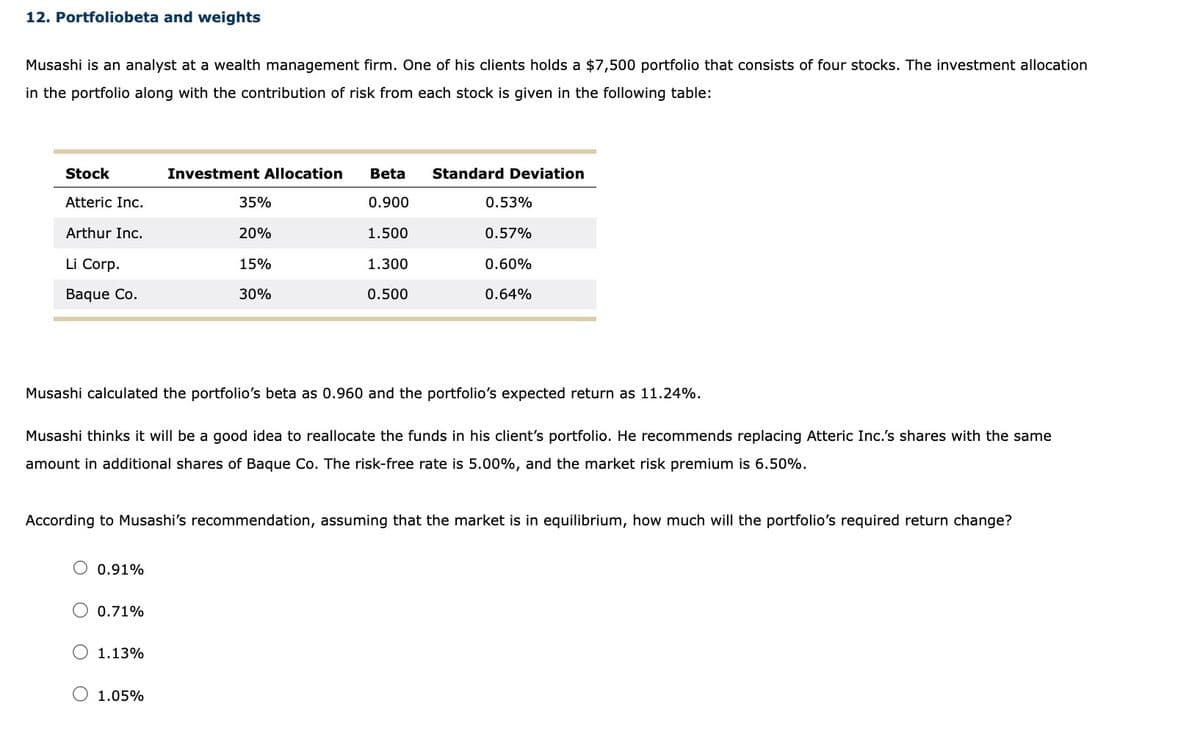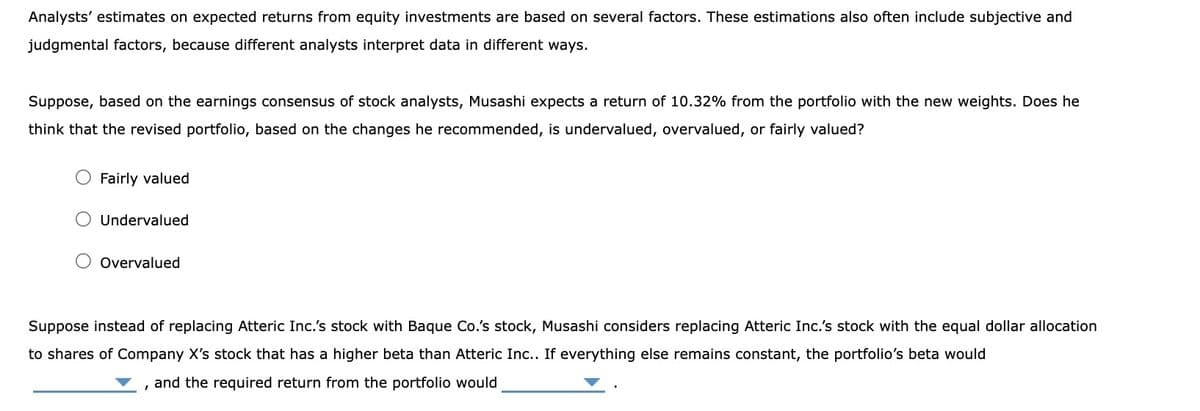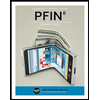Musashi is an analyst at a wealth management firm. One of his clients holds a $7,500 portfolio that consists of four stocks. The investment allocation in the portfolio along with the contribution of risk from each stock is given in the following table: Stock Atteric Inc. Arthur Inc. Li Corp. Baque Co. 0.91% Investment Allocation Beta 0.900 1.500 1.300 0.500 0.71% 35% 20% Musashi calculated the portfolio's beta as 0.960 and the portfolio's expected return as 11.24%. 1.13% 15% 30% Musashi thinks it will be a good idea to reallocate the funds in his client's portfolio. He recommends replacing Atteric Inc.'s shares with the same amount in additional shares of Baque Co. The risk-free rate is 5.00%, and the market risk premium is 6.50%. 1.05% Standard Deviation According to Musashi's recommendation, assuming that the market is in equilibrium, how much will the portfolio's required return change? 0.53% 0.57% 0.60% 0.64%
Musashi is an analyst at a wealth management firm. One of his clients holds a $7,500 portfolio that consists of four stocks. The investment allocation in the portfolio along with the contribution of risk from each stock is given in the following table: Stock Atteric Inc. Arthur Inc. Li Corp. Baque Co. 0.91% Investment Allocation Beta 0.900 1.500 1.300 0.500 0.71% 35% 20% Musashi calculated the portfolio's beta as 0.960 and the portfolio's expected return as 11.24%. 1.13% 15% 30% Musashi thinks it will be a good idea to reallocate the funds in his client's portfolio. He recommends replacing Atteric Inc.'s shares with the same amount in additional shares of Baque Co. The risk-free rate is 5.00%, and the market risk premium is 6.50%. 1.05% Standard Deviation According to Musashi's recommendation, assuming that the market is in equilibrium, how much will the portfolio's required return change? 0.53% 0.57% 0.60% 0.64%
PFIN (with PFIN Online, 1 term (6 months) Printed Access Card) (New, Engaging Titles from 4LTR Press)
6th Edition
ISBN:9781337117005
Author:Randall Billingsley, Lawrence J. Gitman, Michael D. Joehnk
Publisher:Randall Billingsley, Lawrence J. Gitman, Michael D. Joehnk
Chapter11: Investment Planning
Section: Chapter Questions
Problem 9FPE
Related questions
Question

Transcribed Image Text:12. Portfoliobeta and weights
Musashi is an analyst at a wealth management firm. One of his clients holds a $7,500 portfolio that consists of four stocks. The investment allocation
in the portfolio along with the contribution of risk from each stock is given in the following table:
Stock
Atteric Inc.
Arthur Inc.
Li Corp.
Baque Co.
0.91%
Investment Allocation Beta
0.900
O 0.71%
35%
1.13%
20%
15%
30%
Musashi calculated the portfolio's beta as 0.960 and the portfolio's expected return as 11.24%.
1.05%
1.500
1.300
0.500
Musashi thinks it will be a good idea to reallocate the funds in his client's portfolio. He recommends replacing Atteric Inc.'s shares with the same
amount in additional shares of Baque Co. The risk-free rate is 5.00%, and the market risk premium is 6.50%.
Standard Deviation
According to Musashi's recommendation, assuming that the market is in equilibrium, how much will the portfolio's required return change?
0.53%
0.57%
0.60%
0.64%

Transcribed Image Text:Analysts' estimates on expected returns from equity investments are based on several factors. These estimations also often include subjective and
judgmental factors, because different analysts interpret data in different ways.
Suppose, based on the earnings consensus of stock analysts, Musashi expects a return of 10.32% from the portfolio with the new weights. Does he
think that the revised portfolio, based on the changes he recommended, is undervalued, overvalued, or fairly valued?
Fairly valued
Undervalued
Overvalued
Suppose instead of replacing Atteric Inc.'s stock with Baque Co.'s stock, Musashi considers replacing Atteric Inc.'s stock with the equal dollar allocation
to shares of Company X's stock that has a higher beta than Atteric Inc.. If everything else remains constant, the portfolio's beta would
and the required return from the portfolio would
Expert Solution
This question has been solved!
Explore an expertly crafted, step-by-step solution for a thorough understanding of key concepts.
This is a popular solution!
Trending now
This is a popular solution!
Step by step
Solved in 5 steps with 5 images

Knowledge Booster
Learn more about
Need a deep-dive on the concept behind this application? Look no further. Learn more about this topic, finance and related others by exploring similar questions and additional content below.Recommended textbooks for you

PFIN (with PFIN Online, 1 term (6 months) Printed…
Finance
ISBN:
9781337117005
Author:
Randall Billingsley, Lawrence J. Gitman, Michael D. Joehnk
Publisher:
Cengage Learning


PFIN (with PFIN Online, 1 term (6 months) Printed…
Finance
ISBN:
9781337117005
Author:
Randall Billingsley, Lawrence J. Gitman, Michael D. Joehnk
Publisher:
Cengage Learning
